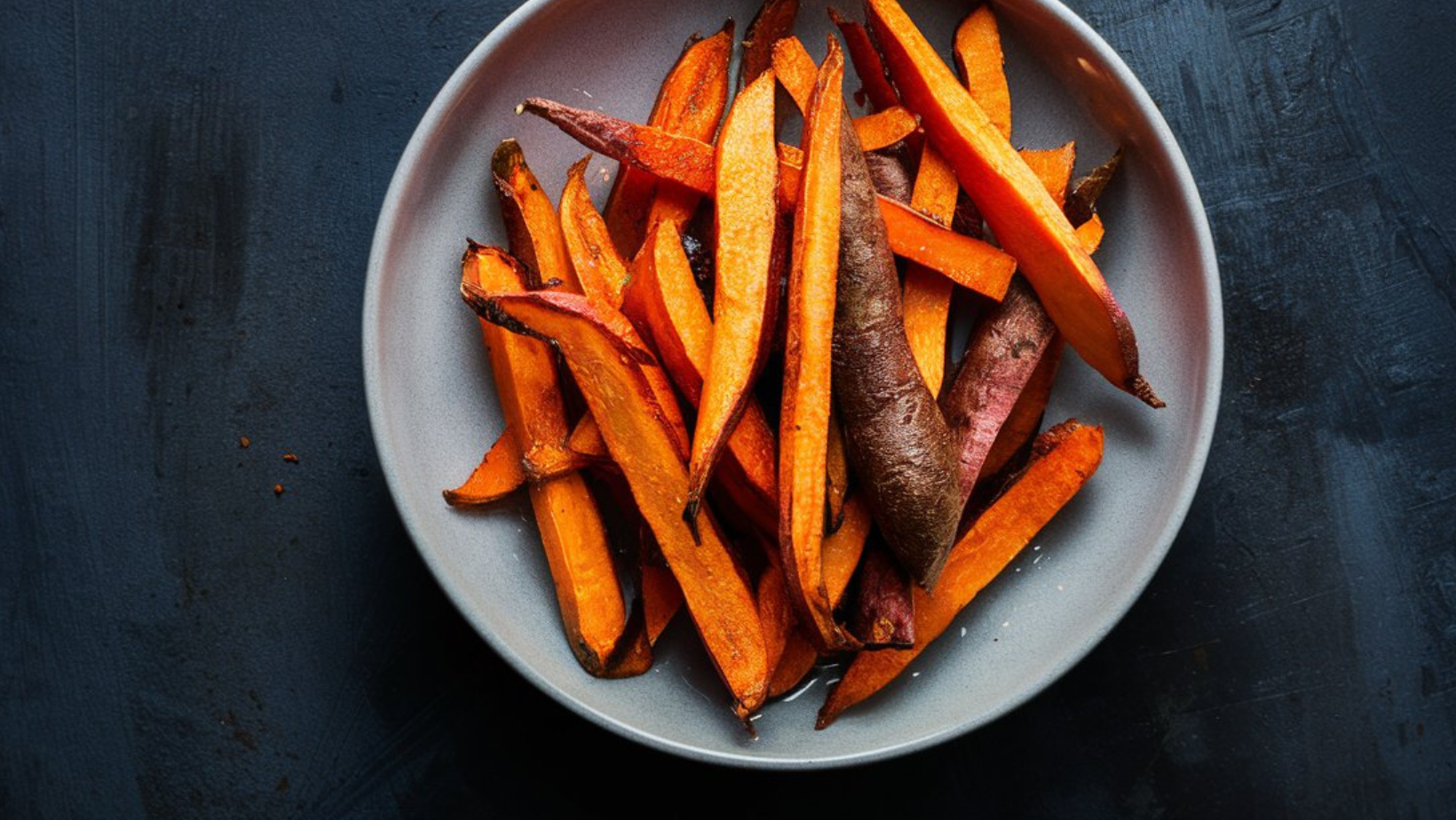Introduction to Air Frying Sweet Potatoes
The Popularity of Air Fryer Sweet Potato Fries
Air fryers have become extremely popular due to their ability to create delightful, crispy foods using minimal oil. Sweet potatoes, known for their rich flavor and numerous health benefits, are especially compatible with this cooking method. However, to enhance your air frying experience further, understanding why soaking sweet potatoes before air frying is beneficial is crucial. This process not only reduces their starch content but also contributes to achieving that perfect crunch and a visually appealing golden exterior, enhancing both the texture and appearance of the sweet potatoes.
Overview of Soaking Sweet Potatoes
Soaking sweet potatoes before air frying is a technique embraced by many cooking enthusiasts to optimize the texture of the fries. This process involves submerging the potato slices in water for anywhere from thirty minutes to a couple of hours. But why exactly should you consider this extra step? Soaking helps to remove excess starch from the surface of the sweet potatoes, which can inhibit the fries from achieving maximum crispiness. By reducing the starch, the sweet potatoes can fry up more evenly and turn gloriously golden.
By understanding these foundational techniques, you can enhance not only the taste and texture of your sweet potato fries but also your overall air frying experience. As we move further into the science behind this process, you’ll discover the transformative effects soaking has on your favorite air-fried dishes.
The Science Behind Soaking Sweet Potatoes
What Happens When You Soak Sweet Potatoes?
When sweet potatoes are soaked in water before air frying, a significant transformation occurs at the molecular level. The water acts as a medium to draw out the soluble starches from the potatoes. This is crucial because starch can create a steam barrier when heated, which prevents the slices from becoming crispy. By leaching out this starch, the sweet potatoes are left with a purer form of their flesh that can crisp up more efficiently in the hot air of the fryer.
Benefits of Removing Starch
Removing starch from sweet potatoes not only enhances their ability to crisp but also improves their overall texture and flavor. With less starch, the natural sweetness of the potatoes shines through, complemented by a satisfying crunch. Furthermore, less starch means that each bite is not just crispy but also lighter and less dense. This makes your air-fried sweet potatoes not just tastier but also more enjoyable to eat, as they lose that heavy, overly chewy texture that can sometimes occur with denser fries.
This part of the process is essential for anyone looking to master the art of making perfect air-fried sweet potatoes. Understanding the changes that occur during soaking can help you manipulate the outcome to your advantage, ensuring that every batch of sweet potatoes you air fry comes out impeccably crispy and delicious. As we explore further preparation techniques, the nuances of cutting and timing will further demystify the path to perfect sweet potato fries.
Preparing Sweet Potatoes for Air Frying
How to Properly Soak Sweet Potatoes
Soaking sweet potatoes for air frying is a straightforward yet impactful step. Begin by peeling your sweet potatoes, although this is optional depending on your preference for skin-on or skinless fries. Cut the potatoes into uniform strips to ensure even cooking. Next, submerge these strips in a bowl of cold water. Let them soak for at least 30 minutes, though some prefer up to two hours for optimal starch removal. This duration allows enough time for the water to penetrate the starchy layers and improve the fries’ texture upon cooking.
Cutting Techniques for Optimal Results
The way you cut sweet potatoes can significantly affect their cooking outcome. Strive for consistency in thickness; ideally, each fry should be about a quarter-inch thick. Consistent sizing not only helps in cooking the fries evenly but also plays a critical role in achieving that coveted crispy exterior. When cutting, use a sharp chef’s knife for precision and safety. If the pieces are too thick, they may not cook through evenly, remaining soggy inside. Too thin, and they might burn or become too crisp, losing their pleasant mouthfeel.
By taking the time to soak and cut your sweet potatoes properly, you set the stage for a successful air frying experience. These steps, though seemingly minor, go a long way in enhancing the final product’s quality, ensuring that each fry is perfectly crispy and deliciously tender on the inside. As we move on to discuss specific cooking tips, these preparatory steps will integrate seamlessly, showing how each phase of the process contributes to the perfect batch of air-fried sweet potatoes.
Tips for Air Frying Soaked Sweet Potatoes
Ideal Cooking Temperatures and Times
Once your sweet potatoes are soaked and sliced, the next step is to air fry them to perfection. Preheat your air fryer to 375°F (190°C)—this temperature is ideal for achieving a crispy exterior without burning the fries. The cooking time will generally range from 15 to 20 minutes, depending on the thickness of your fries and the specific model of your air fryer. It’s important to shake the basket halfway through the cooking process to ensure that the fries cook evenly on all sides and achieve a uniform crispiness.
Arranging Sweet Potatoes in the Air Fryer
How you arrange the sweet potato slices in the air fryer basket can significantly impact their crispiness. Avoid overcrowding; air needs to circulate freely around each fry to cook them properly. Lay the fries in a single layer with space between them. If necessary, cook in multiple batches to prevent the fries from steaming instead of frying. This spacing is crucial for the hot air to envelop each piece fully, allowing the outside to become beautifully crispy while the inside remains soft and tender.
By following these specific tips on temperature, timing, and arrangement, you’ll be well on your way to making the best air fryer sweet potato fries. These are not just instructions but the subtle art of air frying—understanding and manipulating these variables can make all the difference in the outcome of your dish. As we continue to explore the nuances of air frying, we will delve into a comparative analysis that examines whether soaking is truly necessary for achieving the ultimate sweet potato fry.
To Soak or Not to Soak?
Differences in Texture and Taste
The debate over whether to soak sweet potatoes before air frying can hinge significantly on personal preferences for texture and taste. For those who favor a particularly crispy exterior with a soft, fluffy interior, soaking is beneficial. It reduces the starch content, which, as previously discussed, can hinder the crisping process by trapping moisture within the fries. On the other hand, some may skip soaking if they prefer a denser, slightly chewier texture, as the retained starch contributes to this quality.
Personal Preferences and Variations in Results
Experimentation is key in the kitchen, and air-frying sweet potatoes offers a perfect opportunity to customize your cooking method to suit your taste. Some find that a light soak, perhaps just 30 minutes, strikes the right balance between reducing starch and maintaining some of the potato’s natural texture. Others may find that longer soaking times, up to two hours, provide the best results for their taste buds. Additionally, the type of sweet potato used can affect the outcome, as some varieties are naturally starchier than others.
This part of our guide serves to remind us that cooking is as much about personal expression as it is about following recipes. While science provides a guideline, personal preference plays a crucial role in defining what makes the perfect sweet potato fry for you. As we wrap up with our frequently asked questions section, remember that the best cooking practices often come from a mix of knowledge and personal experimentation.
Nutritional Benefits of Air Frying Sweet Potatoes
Healthier Cooking with Less Oil
Air frying sweet potatoes allows for a significant reduction in oil usage compared to traditional deep frying. This cooking method uses circulating hot air to achieve a crispy texture, eliminating the need for submerging the food in oil. The result is a lower overall fat content, which is beneficial for heart health and helps in managing calorie intake more effectively.
Retaining Nutrients
Sweet potatoes are a rich source of vitamins, particularly Vitamin A in the form of beta-carotene, as well as minerals and fibers. Air frying, as a cooking method, can help retain more of these vital nutrients compared to frying in oil. The quicker cooking times and lower temperatures preserve the sweet potatoes’ nutritional profile better than the high heat of deep frying, which can degrade some vitamins and minerals.
This additional section can further emphasize the advantages of air frying not just from a culinary perspective but also from a health standpoint, making the case for why switching to an air fryer can be a beneficial move for anyone looking to enjoy delicious foods in a healthier way.
Frequently Asked Questions
Why are my air fryer sweet potato fries soggy?
Soggy sweet potato fries can result from several factors: not soaking the potatoes to remove excess starch, overcrowding the air fryer basket, or setting the temperature too low. Ensuring that you allow enough space for air circulation and using the right temperature can drastically improve the crispiness of your fries.
How long should I soak sweet potatoes before air frying?
The recommended soaking time for sweet potatoes before air frying ranges from 30 minutes to 2 hours. Soaking for at least 30 minutes helps to remove some of the surface starch, which can improve the crispiness of the fries. Experiment with different durations to find what works best for your taste and the specific type of sweet potato you’re using.
Can I air-fry sweet potatoes without soaking them?
Yes, you can air fry sweet potatoes without soaking them, but the results may vary. Not soaking the potatoes will likely result in fries that are less crispy and possibly denser, due to the higher starch content. For those who prefer a crunchier texture, soaking is advisable.
This FAQ section aims to address common concerns and questions that arise when making air fryer sweet potato fries. By understanding these aspects, you can adjust your cooking process to better meet your preferences and achieve the desired results. As we conclude with our final thoughts on the benefits of soaking sweet potatoes, it becomes clear that a little extra preparation can go a long way in enhancing your culinary creations.
Conclusion
Key Takeaways
Soaking sweet potatoes before air frying is more than just an extra step; it’s a technique that can significantly enhance the final product. By removing excess starch, soaking helps to achieve a crisper exterior and a more enjoyable texture overall. Whether or not you choose to soak your sweet potatoes may depend on your personal taste preferences and the specific results you are aiming for.
Encouraging Experimentation
Ultimately, the best way to discover your perfect sweet potato fry is through experimentation. Try different soaking times, adjust the thickness of your cuts, experiment with various air frying temperatures and times, and see what combination works best for you. The flexibility and adaptability of air frying, combined with these tips, provide a foundation on which you can build your unique culinary creations.
In conclusion, while the science and tips provided here offer a guideline, the art of cooking lies in the personal touches you add. Soaking sweet potatoes for air frying is a simple yet effective way to improve your dishes, proving that sometimes, the best results come from paying attention to the details. Whether you’re seeking the ultimate crispiness or a specific texture, the journey to perfecting your sweet potato fries can be as rewarding as the delicious results.

